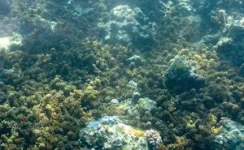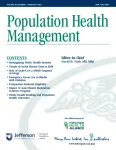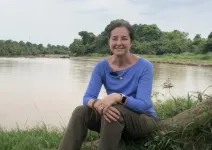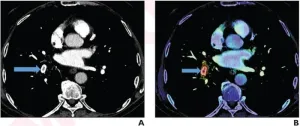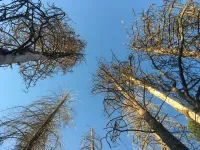(Press-News.org) Natural disasters can devastate a region, abruptly killing the species that form an ecosystem’s structure. But how this transpires can influence recovery. While fires scorch the landscape to the ground, a heatwave leaves an army of wooden staves in its wake. Storm surges and coral bleaching do something similar underwater.
UC Santa Barbara scientists investigated how these two kinds of disturbances might affect coral reefs. They found that coral struggles more to recover from bleaching than from storms, even when mortality was similar between the two events. The skeletons left behind after bleaching appear to offer protection to algae, which then edge out the slow-growing coral. The study, led by doctoral student Kai Kopecky, appears in the journal Ecology.
Most shallow-water corals host symbiotic algae that provide the animals with food in exchange for a safe home and nutrients. But extreme conditions can throw this arrangement out of alignment, causing the coral to expel their partners in a process known as bleaching, which is often fatal.
Researchers at UC Santa Barbara have studied coral and their reef ecosystems around the island of Moorea, French Polynesia since the late 1980s. Kopecky’s second visit to the island coincided with a major bleaching event. “To see lots of bright white coral skeletons is very jarring,” he said, but he took solace that the island’s reefs have proven remarkably resilient in the past.
Unfortunately a different pattern began to emerge this time. Seaweed, a major competitor with coral for space on the reef, began colonizing the bleached skeletons. Kopecky wondered if the skeletons’ presence was setting the reef on a pathway toward a more algae-dominated state.
Previous work at Moorea showed that tropical reefs can host either coral- or seaweed-dominated communities. These distinct states are resilient to small disturbances, but a large shock can flip the ecosystem from one to the other in a process called hysteresis. Once this happens, the reef won’t revert to its previous state even if the conditions do. The system has found a new equilibrium.
Kopecky developed a mathematical model to compare reef dynamics after a bleaching event — which leaves skeletons in place — and after a storm — which scours the reef bare. He used a system of five differential equations to capture the transition between empty space, live and dead branching coral, and seaweed cover on the reef.
The results were telling. “Just the fact that those skeletons are left on the reef results in these fundamentally different patterns of recovery,” Kopecky said.
Coral skeletons seem to protect young algae from herbivores that would otherwise keep it in check. The animals can’t get in all the crevices, so the algae gains a foothold from which to spread.
This protection doesn’t appear to provide the same benefits to young coral. The authors suspect that coral don’t face as much pressure from predators as algae do. What’s more, algae can quickly outgrow coral when given the chance. “Coral is literally laying down rock, while the algae are mostly just fast-growing, soft, leafy material,” said senior author Holly Moeller, an assistant professor of ecology, evolution and marine biology.
Reef buildup is a slow process, with coral death usually balanced by recruitment. New growth incorporates dead skeletons into the larger reef structure. But bleaching kills a lot of coral all at once — especially the oldest and youngest — and the skeletons eventually become brittle through erosion. It’s not a strong foundation for young coral to build their lives upon.
If dead skeletons hinder coral recovery, why not simply remove them?
This approach is gaining support in other ecosystems. “Think of prescribed fires or the thinning of dead trees in forests so that the system is more resilient to future disturbances,” Kopecky said.
However, coral skeletons provide many benefits. They form habitat for sundry kinds of animals and some evidence suggests that the structural complexity of a reef correlates with faster coral recovery.
“The effect really depends on what the nature of that structure is,” Kopecky said. Material density, strength and spatial layout all influence reef dynamics. “Those aspects need to be taken into consideration before you go out and just start jackhammering the reef.”
The team has a suite of ongoing experiments in Moorea, including one exploring how the reef recovers when dead coral skeletons are removed. Several others are testing the assumptions Kopecky used to create his model. For example, how much does dead coral actually reduce herbivory? And how do the skeletons affect the growth of living corals?
“Kai’s study is a classic example of the value of mathematical models in ecology,” Moeller said. Coral can live for hundreds of years, and reef recovery can take decades. “That’s just not an experiment that you can do realistically.
“But if you have a model,” she continued, “and you trust the way you set that model up because you’ve done other experiments, then you can make these projections decades into the future.”
END
Stripped to the bone
Research in Moorea shows the presence of coral skeletons influences reef recovery after bleaching
2023-04-05
ELSE PRESS RELEASES FROM THIS DATE:
Emory researchers discover key pathway for COVID organ damage in adults
2023-04-05
Even after three years since the emergence of COVID-19, much remains unknown about how it causes severe disease, including the widespread organ damage beyond just the lungs. Increasingly, scientists are learning that organ dysfunction results from damage to the blood vessels, but why the virus causes this damage is unclear. Now a multidisciplinary team of Emory researchers has discovered what they believe is the key molecular pathway.
Results of their study, published today in Nature Communications, show that COVID-19 damages the cells lining the smallest blood vessels, choking off blood flow. These results could pave the way for new treatments to save lives at a time when hundreds ...
Population Health Management
2023-04-05
The COVID-19 pandemic has underscored the inequality in American health care systems, which consistently neglect the needs of underserved communities, leaving them without access to quality care. A commentary published in Population Health Management highlights the need for a transformational change in our health care systems to advance health equity and address structural racism and health disparities affecting wellbeing. Click here to read the article now.
Coauthors Dr. Jonathan B. Perlin, President ...
Teens who trust online information find it less stressful
2023-04-05
ITHACA, N.Y. -- Teens’ trust in the news they consume on social media – or lack of it – may be key to whether it supports or detracts from their well-being, according to Cornell-led psychology research.
Surveying nearly 170 adolescents and young adults from the U.S. and U.K. early in the pandemic, the researchers found that those more trusting of the COVID-19 information they saw on Facebook, Twitter and TikTok were more likely to feel it was empowering, while those less trusting were more likely to find it stressful.
The findings highlight the need for news literacy programs to help young people discern fact-based, trustworthy sources from misinformation ...
WCS names new President and CEO - Monica P. Medina
2023-04-05
The Wildlife Conservation Society (WCS) announced today that Monica P. Medina, the first diplomat in the U.S. designated to advocate for global biodiversity, has been named WCS President and CEO, effective June 1, 2023. Medina, current Assistant Secretary of State for Oceans, Environment, and Science; and Special Envoy for Biodiversity and Water Resources will serve until April 30, 2023, at the U.S. Department of State.
Medina ushered in a new era of environmental diplomacy as a foreign policy priority at the State Department. She will join WCS to lead its mission to save wildlife and wild places, harnessing the power of its four zoos, an aquarium, and its Global ...
IU researchers receive $8.6M NIH grant renewal to study alcohol use, binge drinking
2023-04-05
INDIANAPOLIS--A multi-disciplinary team of Indiana University researchers is focusing their efforts on a growing public health concern: binge and “high-intensity” drinking—extreme drinking behaviors that are increasingly prevalent among college-age adults.
The researchers, who are part of the Indiana Alcohol Research Center, recently received a five-year, $8.65 million grant renewal from the National Institute on Alcohol Abuse and Alcoholism to support this work.
Established in 1987, the Indiana Alcohol Research Center (IARC) is housed at IU School of Medicine and led by director David Kareken, PhD, a professor of ...
Looking beyond the horizon
2023-04-05
Texas Tech’s Thomas Maccarone has received a grant from the U.S. Air Force Office of Scientific Research to study possible impacts of one layer of the earth’s ionosphere upon radio communications.
Maccarone, a professor in the Department of Physics and Astronomy, said the project will have short- and long-term benefits and implications. The one-year grant is for just more than $500,000.
“We will use a set of dipole radio antennas to study what is called the sporadic E-layer of the ionosphere,” he said. “That is the short-term component the Air Force ...
AI cuts CT turnaround, wait times for positive pulmonary embolus
2023-04-05
Leesburg, VA, April 5, 2023—According to an accepted manuscript published in ARRS’ own American Journal of Roentgenology (AJR), a worklist reprioritization tool with artificial intelligence reduced both report turnaround time and wait time for pulmonary embolus-positive CT pulmonary angiography examinations.
“By assisting radiologists in providing rapid diagnoses, the artificial intelligence (AI) tool could potentially enable earlier interventions for acute pulmonary embolus (PE),” concluded lead researcher Kiran Batra, MD, from the department of radiology at University of Texas Southwestern Medical ...
Gone for good? California’s beetle-killed, carbon-storing pine forests may not come back
2023-04-05
LOS ALAMOS, N.M., April 4, 2023—Ponderosa pine forests in the Sierra Nevada that were wiped out by western pine beetles during the 2012-2015 megadrought won’t recover to pre-drought densities, reducing an important storehouse for atmospheric carbon.
“Forests store huge amounts of atmospheric carbon, so when western pine beetle infestations kill off millions of trees, that carbon dioxide goes back into the atmosphere,“ said Zachary Robbins, a postdoctoral at Los Alamos National Laboratory.
Robbins is corresponding author of a new paper published in the journal Frontiers in Environmental Science about carbon stored in living ponderosa pines in the ...
Dual quasars blaze bright at the center of merging galaxies
2023-04-05
Galaxies grow and evolve by merging with other galaxies, blending their billions of stars, triggering bursts of vigorous star formation, and often fueling their central supermassive black holes to produce luminous quasars that outshine the entire galaxy. Some of these mergers eventually go on to become massive elliptical galaxies that contain black holes that are many billions of times the mass of our Sun. Although astronomers have observed a veritable menagerie of merging galaxies with more than one quasar in our own cosmic neighborhood, more distant examples, seen when the Universe was only a quarter of its current age, are quite rare and ...
SFU research aids fight against treatment-resistant superbugs
2023-04-05
Researchers at Simon Fraser University are studying the genes of superbugs to aid the development of new and effective treatments for drug-resistant bacterial infections. Superbugs are characterized as infection-causing bacteria resistant to treatment with antibiotics.
“Antimicrobial resistance occurs when the disease-causing bacteria has ways to overcome the antibiotics that we use in treatment for infections,” says assistant professor Amy Lee, of SFU's Department of Molecular Biology and Biochemistry. The initiative is a collaboration between the Lee Lab and Brinkman Lab, which are working together as ...
LAST 30 PRESS RELEASES:
Scalable and healable gradient textiles for multi‑scenario radiative cooling via bicomponent blow spinning
Research shows informed traders never let a good climate crisis go to waste
Intelligent XGBoost framework enhances asphalt pavement skid resistance assessment
Dual-function biomaterials for postoperative osteosarcoma: Tumor suppression and bone regeneration
New framework reveals where transport emissions concentrate in Singapore
NTP-enhanced lattice oxygen activation in Ce-Co catalysts for low-temperature soot combustion
Synergistic interface engineering in Cu-Zn-Ce catalysts for efficient CO2 hydrogenation to methanol
COVID-19 leaves a lasting mark on the human brain
Scientists use ultrasound to soften and treat cancer tumors without damaging healthy tissue
Community swimming program for Black youth boosts skills, sense of belonging, study finds
Specific depressive symptoms in midlife linked to increased dementia risk
An ‘illuminating’ design sheds light on cholesterol
Who is more likely to get long COVID?
Study showcases resilience and rapid growth of “living rocks”
Naval Research Lab diver earns Office of Naval Research 2025 Sailor of the Year
New Mayo-led study establishes practical definition for rapidly progressive dementia
Fossil fuel industry’s “climate false solutions” reinforce its power and aggravate environmental injustice
Researchers reveal bias in a widely used measure of algorithm performance
Alcohol causes cancer. A study from IOCB Prague confirms damage to DNA and shows how cells defend against it
Hidden viruses in wastewater treatment may shape public health risks, study finds
Unlock the power of nature: how biomass can transform climate mitigation
Biochar reshapes hidden soil microbes that capture carbon dioxide in farmland
Reducing saturated fat intake shows mortality benefit, but only in high-risk individuals
Manta rays create mobile ecosystems, study finds
Study: Mixed results in using lipoic acid to treat progressive multiple sclerosis
Norbert Holtkamp appointed director of Fermi National Accelerator Laboratory
New agentic AI platform accelerates advanced optics design
Biologists discover neurons use physical signals — not electricity — to stabilize communication
Researchers discover that a hormone can access the brain by hitchhiking
University of Oklahoma researcher awarded funding to pursue AI-powered material design
[Press-News.org] Stripped to the boneResearch in Moorea shows the presence of coral skeletons influences reef recovery after bleaching

